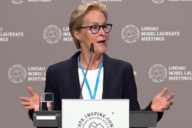You have /5 articles left.
Sign up for a free account or log in.
The first time INTO University Partnerships approached George Mason University about a potential collaboration the university turned the company down, opting to develop a transition program for international students on its own rather than with the help of a corporate partner. But George Mason’s four-year-old bridge programs -- which combine academic and intensive English courses into a “pathway” year for international students -- never attained the scale administrators wanted. When INTO came knocking a second time the university said yes.
George Mason announced on Thursday that it is finalizing a joint venture agreement with INTO, pending approval by the university’s Board of Visitors in December. INTO's model is to form long-term joint ventures with universities to help them expand their international student recruitment and intensive English and pathway programs. Pending board approval, George Mason will be INTO's fifth American university partner and its first in a major metropolitan area (the university is located in Fairfax, Va., just outside Washington, D.C.).
George Mason's provost, Peter N. Stearns, said that two things have changed since INTO's initial approach. The first is that the British-based company has established a track record with American universities: its partnership with Oregon State University is now in its fifth year, and it has since launched programs at the University of South Florida, Colorado State University and, most recently this fall, Marshall University. The second is that George Mason has a more acute sense of its own limitations.
"Having built a successful transition program here we also realize that we face some clear limitations in expanding it to the scale we would like in meeting the university’s goals for internationalization,” Stearns said, explaining that the university simply doesn’t have the capital to replicate INTO’s recruiting network. George Mason is currently enrolling a total of about 140 students in its undergraduate and graduate pathway programs and another 180 in its English Language Institute. It hopes, through the partnership with INTO, to increase the number of international students coming to George Mason by an additional 300 to 400 a year. Universities across the U.S. are on the hunt for more international students, both for the diversity they bring to the classroom and for their tuition dollars.
"They have built an amazingly high-quality pathway program on their own," David Stremba, INTO's managing director for North America, said of George Mason. "I think the challenge for Mason, as for other institutions, is to have the depth of resources available to be able to invest in a significant way in marketing and promotion, the physical facilities, and the student experience.”
Stremba said that INTO's first site in North America, Oregon State, has 1,305 students enrolled this fall in INTO OSU programs, which are housed in a new(ish) $52 million center. South Florida's INTO USF, now in its fourth year, has 709 students and Colorado State's INTO CSU, in its second, 535. INTO Marshall, in its first year, has 170. These figures all represent significant increases from the numbers of students enrolled in these universities' intensive English institutes prior to the start of the INTO partnership.
Corporate partners can bring resources for recruitment and new buildings, but the proliferation of pathway programs run in cooperation with for-profit entities like INTO has been controversial, raising concerns about the outsourcing of intensive English programs and issues of academic quality. Many intensive English professionals have watched the emergence of corporate ESL and pathway providers like INTO with concern.
Joy Tesh, the president of the consortium of University and College Intensive English Programs, said that if the proposed joint venture unfolds as it has at other institutions, George Mason's English Language Institute will no longer be eligible for UCIEP membership. Both the University of South Florida and Oregon State were removed from the consortium's rolls after they affiliated with INTO, she said. UCIEP's guidelines, posted on its website, state that "UCIEP membership is not open to IEPs that are managed or controlled either fully or in part by for-profit enterprises, including 'joint venture' enterprises in which one or more parties is for-profit."
Both Stremba and Stearns emphasized that George Mason has full control over academic matters under the terms of the proposed joint venture with INTO -- that the academic programs will be George Mason programs taught by faculty employed by George Mason.
Stearns said that all faculty members currently teaching in the pathway programs and the English Language Institute have been assured that they will retain their status as George Mason employees, though their job descriptions may in some cases change. However, he noted that “it would be misleading not to acknowledge that there's a certain amount of anxiety, particularly in the ELI group. We hope to build on the strength of the operation but we have to acknowledge change is involved and change is always a little bit unsettling.”
At an open faculty forum on the proposed INTO partnership this week, Charlene Douglas, the chair of George Mason's Faculty Senate, said there was significant concern expressed about the well-being of faculty in the English Language Institute. Douglas said that participants at the forum also raised questions about minimum Test of English as a Foreign Language scores and grade point averages and whether they would be lowered under this new arrangement. A George Mason spokeswoman said that nothing's been decided yet in regards to entry requirements for the proposed INTO George Mason programs.
“People are very concerned about their ELI colleagues," said Douglas, an associate professor of nursing. "They don’t want them displaced, dumped on, stretched beyond capacity. I don’t think the influx of students is the issue, but we do want students who are able to handle the language at a college level."
George Mason said that working groups made up of more than 100 professors, staff members, students and INTO representatives are helping to design the partnership agreement. "There has been a very transparent process here at Mason from the beginning of the summer which has involved all of us -- by all of us, I mean various members of the wider Mason community and membership from the English Language Institute as well," said John Pope, the institute's executive director.
"Of course there are challenges, but since we do have a seat at the table, and since we are part of the process, we are hopeful that the ultimate outcome will be something that will really work," Pope continued.
Nicole J. Sealey is the founding director of the Center for International Student Access, which houses George Mason's existing pathway programs. She echoed Pope in saying that she has been involved from the beginning in discussions. And she said that her involvement in those discussions has allayed any concerns about quality she might otherwise have had.
"We are the first school that INTO has ever approached that already had pathway programs. They came in saying, 'Let’s hear about your program; what do you do?' ” said Sealey, who added that she's optimistic that "the majority of the academic content and structure is going to remain largely intact."
Carter A. Winkle, an assistant professor in curriculum and instruction at Barry University and an expert on TESOL said that without knowing George Mason’s full rationale he found the decision to partner with INTO “disappointing.” George Mason’s existing pathway program is one of several alternatives to corporate partnerships that Winkle discusses in his forthcoming book, University Partnerships with the Corporate Sector: Faculty Experiences with For-Profit Matriculation Pathway Programs (Brill).
Winkle's position is that universities have many intelligent people who can create and sustain such programs on their own. He added that if it’s really a numbers issue at George Mason, then the question "is whether or not they’re allocating resources for recruitment in a way that’s successful."
Winkle said that if universities do feel the need to find a corporate partner, he recommends in his book that they consider finding one solely for recruiting purposes (rather than for help in developing academic programs and student services). “There’s no need for a corporate partner to run the whole show,” he said.




